Copyright
©The Author(s) 2020.
World J Clin Cases. Dec 6, 2020; 8(23): 6197-6205
Published online Dec 6, 2020. doi: 10.12998/wjcc.v8.i23.6197
Published online Dec 6, 2020. doi: 10.12998/wjcc.v8.i23.6197
Figure 1 Photographic images of the patient showing signs of Cushing syndrome.
A-C: Abdominal obesity with thin arms and legs, acne, a round face and a fat lump between the shoulders (orange arrows); D: Poorly developed teeth; E and F: Thumb duplication on the left hand (orange arrow).
Figure 2 Radiography examination results.
A: Anterior view; B: Posterior view of skeletal scintigraphy showing the location of the bone lesions on left ischium and left fibula, talus, and calcaneus (orange arrows); C and D: Computed tomography shows well-circumscribed bone lucencies and ground-glass opacities in left talus and calcaneus (yellow arrows).
Figure 3 Pathological reports.
A: Fibrous and osseous tissue are present in varying proportions [hematoxylin-eosin (HE), 40 ×]. The box shows the view field of B; B: The fibrous tissue is composed principally of bland fibroblastic cells. Mitoses are uncommon (HE, 100 ×). The box shows the view field of C; C: The osseous component is comprised of irregular, curvilinear, trabeculae of woven or rarely lamellar woven bone (HE; 200 ×).
Figure 4 Sequencing chromatograms of the analyzed genes.
A: Results for HSPG2; B: Results for RIMS1. The red arrows indicate the variants in HSPG2 (c.6913G>A, p.Asp2305Asn) and RIMS1 (c.3139del, p.Thr1047His). The variants indicate a maternal source.
Figure 5 Possible genetic pedigree: The inheritance of HSPG2 and RIMS1.
The HSPG2 mutation is homozygous, while the RIMS1 mutation is heterozygous. The abnormal genotype of HSPG2 is likely caused by uniparental disomy, a single chromosome from her mother is duplicated leading to the homozygous mutation in HSPG2.
- Citation: Lin T, Li XY, Zou CY, Liu WW, Lin JF, Zhang XX, Zhao SQ, Xie XB, Huang G, Yin JQ, Shen JN. Discontinuous polyostotic fibrous dysplasia with multiple systemic disorders and unique genetic mutations: A case report. World J Clin Cases 2020; 8(23): 6197-6205
- URL: https://www.wjgnet.com/2307-8960/full/v8/i23/6197.htm
- DOI: https://dx.doi.org/10.12998/wjcc.v8.i23.6197













